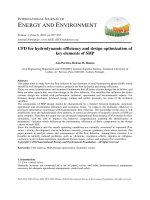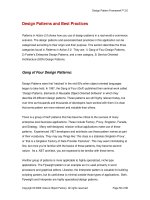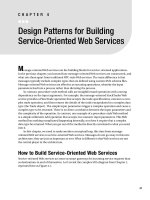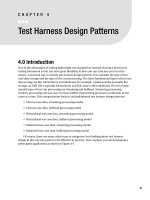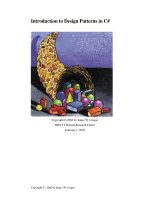Design Patterns: Elements of Reusable ObjectOriented Software
Bạn đang xem bản rút gọn của tài liệu. Xem và tải ngay bản đầy đủ của tài liệu tại đây (18.31 MB, 417 trang )
Creational Patterns
Abstract Factory (87) Provide an interface for creating families of related or dependent
objects without specifying their concrete classes.
Builder (97) Separate the construction of a complex object from its representation so
that the same construction process can create different representations.
Factory Method (107) Define an interface for creating an object, but let subclasses decide which class to instantiate. Factory Method lets a class defer instantiation to
subclasses.
Prototype (117) Specify the kinds of objects to create using a prototypical instance, and
create new objects by copying this prototype.
Singleton (127) Ensure a class only has one instance, and provide a global point of
access to it.
Structural Patterns
Adapter (139) Convert the interface of a class into another interface clients expect.
Adapter lets classes work together that couldn't otherwise because of incompatible interfaces.
Bridge (151) Decouple an abstraction from its implementation so that the two can vary
independently.
Composite (163) Compose objects into tree structures to represent part-whole hierarchies. Composite lets clients treat individual objects and compositions of objects
uniformly.
Decorator (175) Attach additional responsibilities to an object dynamically. Decorators
provide a flexible alternative to subclassing for extending functionality.
Facade (185) Provide a unified interface to a set of interfaces in a subsystem. Facade
defines a higher-level interface that makes the subsystem easier to use.
Flyweight (195) Use sharing to support large numbers of fine-grained objects efficiently.
Proxy (207) Provide a surrogate or placeholder for another object to control access to
it.
Behavioral Patterns
Chain of Responsibility (223) Avoid coupling the sender of a request to its receiver by
giving more than one object a chance to handle the request. Chain the receiving
objects and pass the request along the chain until an object handles it.
Command (233) Encapsulate a request as an object, thereby letting you parameterize clients with different requests, queue or log requests, and support undoable
operations.
Interpreter (243) Given a language, define a represention for its grammar along with
an interpreter that uses the representation to interpret sentences in the language.
Iterator (257) Provide a way to access the elements of an aggregate object sequentially
without exposing its underlying representation.
Mediator (273) Define an object that encapsulates how a set of objects interact. Mediator promotes loose coupling by keeping objects from referring to each other
explicitly, and it lets you vary their interaction independently.
Memento (283) Without violating encapsulation, capture and externalize an object's
internal state so that the object can be restored to this state later.
Observer (293) Define a one-to-many dependency between objects so that when one
object changes state, all its dependents are notified and updated automatically.
State (305) Allow an object to alter its behavior when its internal state changes. The
object will appear to change its class.
Strategy (315) Define a family of algorithms, encapsulate each one, and make them
interchangeable. Strategy lets the algorithm vary independently from clients that
use it.
Template Method (325) Define the skeleton of an algorithm in an operation, deferring
some steps to subclasses. Template Method lets subclasses redefine certain steps
of an algorithm without changing the algorithm's structure.
Visitor (331) Represent an operation to be performed on the elements of an object
structure. Visitor lets you define a new operation without changing the classes of
the elements on which it operates.
This page intentionally left blank
Design Patterns
Addison-Wesley Professional Computing Series
Brian W. Kernighan, Consulting Editor
Matthew H. Austern, Generic Programming and the STL: Using and Extending the C++ Standard Template Library
David R. Butenhof, Programming with POSIX® Threads
Brent Callaghan, NFS Illustrated
Tom Cargill, C++ Programming Style
William R. Cheswick /Steven M. Bellovin/Aviel D. Rubin, Firewalls and Internet Security, Second Edition: Repelling
the Wily Hacker
David A. Curry, UNIX® System Security: A Guide for Users and System Administrators
Stephen C. Dewhurst, C++ Gotchas: Avoiding Common Problems in Coding and Design
Dan Farmer/Wietse Venema, Forensic Discovery
Erich Gamma/Richard Helm/Ralph Johnson/John Vlissides, Design Patterns: Elements of Reusable ObjectOriented Software
Erich Gamma/Richard Helm/Ralph Johnson/John Vlissides, Design Patterns CD: Elements of Reusable ObjectOriented Software
Peter Haggar, Practical Java"" Programming Language Guide
David R. Hanson, C Interfaces and Implementations: Techniques for Creating Reusable Software
Mark Harrison/Michael McLennan, Effective Tcl/Tk Programming: Writing Better Programs with Tcl and Tk
Michi Henning/Steve Vinoski, Advanced CORBA® Programming with C++
Brian W. Kernighan/Rob Pike, The Practice of Programming
S. Keshav, An Engineering Approach to Computer Networking: ATM Networks, the Internet, and the Telephone Network
John Lakos, Large-Scale C++ Software Design
Scott Meyers, Effective C++ CD: 85 Specific Ways to Improve Your Programs and Designs
Scott Meyers, Effective C++, Third Edition: 55 Specific Ways to Improve Your Programs and Designs
Scott Meyers, More Effective C++: 35 New Ways to Improve Your Programs and Designs
Scott Meyers, Effective STL: 50 Specific Ways to Improve Your Use of the Standard Template Library
Robert B. Murray, C++ Strategies and Tactics
David R. Musser/Gillmer J. Derge/Atul Saini, STL Tutorial and Reference Guide, Second Edition:
C++ Programming with the Standard Template Library
John K. Ousterhout, Tel and the Tk Toolkit
Craig Partridge, Gigabit Networking
Radia Perlman, Interconnections, Second Edition: Bridges, Routers, Switches, and Internetworking Protocols
Stephen A. Rago, UNIX® System V Network Programming
Eric S. Raymond, The Art of UNIX Programming
Marc J. Rochkind, Advanced UNIX Programming, Second Edition
Curt Schimmel, UNIX® Systems for Modern Architectures: Symmetric Multiprocessing and Caching for Kernel Programmers
W. Richard Stevens, TCP/IP Illustrated, Volume 1: The Protocols
W. Richard Stevens, TCP/IP Illustrated, Volume 3: TCP for Transactions, HTTP, NNTP, and the UNIX®
Domain Protocols
W. Richard Stevens/Bill Fenner/Andrew M. Rudoff, UNIX Network Programming Volume 1, Third Edition: The
Sockets Networking API
W. Richard Stevens/Stephen A. Rago, Advanced Programming in the UNIX® Environment, Second Edition
W. Richard Stevens/Gary R. Wright, TCP/IP Illustrated Volumes 1-3 Boxed Set
John Viega/Gary McGraw, Building Secure Software: How to Avoid Security Problems the Right Way
Gary R. Wright/W. Richard Stevens, TCP/IP Illustrated, Volume 2: The Implementation
Ruixi Yuan/W. Timothy Strayer, Virtual Private Networks: Technologies and Solutions
Visit www.awprofessional.com/series/professionalcomputing for more information about these titles.
Design Patterns
Elements of Reusable Object-Oriented Software
Erich Gamma
Richard Helm
Ralph Johnson
John Vlissides
Boston • San Francisco • New York • Toronto • Montreal
London • Munich • Paris • Madrid
Capetown • Sidney • Tokyo • Singapore • Mexico City
Material from A Pattern Language: Towns/Buildings/Construction by Christopher Alexander,
copyright © 1977 by Christopher Alexander is reprinted by permission of Oxford University
Press, Inc.
Many of the designations used by manufacturers and sellers to distinguish their products are claimed as
trademarks. Where those designations appear in this book, and we were aware of a trademark claim, the
designations have been printed in initial capital letters or in all capitals.
The author and publisher have taken care in the preparation of this book, but make no expressed or
implied warranty of any kind and assume no responsibility for errors or omissions. No liability is
assumed for incidental or consequential damages in connection with or arising out of the use of the
information or programs contained herein.
The publisher offers discounts on this book when ordered in quantity for special sales. For more information, please contact:
Pearson Education Corporate Sales Division
201 W. 103rd Street
Indianapolis, IN 46290
(800) 428-5331
Visit AW on the Web: www.awprofessional.com
Library of Congress Cataloging-in-Publication Data
Design Patterns : elements of reusable object-oriented software / Erich Gamma ... [et al.].
p. cm.—(Addison-Wesley professional computing series)
Includes bibliographical references and index.
ISBN 0-201-63361-2
1. Object-oriented programming (Computer science) 2. Computer software—Reusability.
I. Gamma, Erich. II. Series.
QA76.64.D47 1994
005.1'2-dc20
94-34264
CIP
Copyright © 1995 by Addison-Wesley
All rights reserved. No part of this publication may be reproduced, stored in a retrieval system, or
transmitted, in any form, or by any means, electronic, mechanical, photocopying, recording, or otherwise, without the prior consent of the publisher. Printed in the United States of America. Published
simultaneously in Canada.
Cover art © M.C. Escher/Cordon Art - Baarn - Holland. All rights reserved.
ISBN 0-201-63361-2
Text printed in the United States on recycled paper at Courier Westford in Westford, Massachusetts.
37th Printing
March 2009
To Karin
—E.G.
To Sylvie
—R.H.
To Faith
-R.J.
To Dru Ann and Matthew
Joshua 24:15b
—J.v.
Praise for Design Patterns: Elements of Reusable
Object-Oriented Software
"This is one of the best written and wonderfully insightful books that I have read in a great long while...this
book establishes the legitimacy of patterns in the best way: not by argument but by example."
— Stan Lippman, C++ Report
"...this new book by Gamma, Helm, Johnson, and Vlissides promises to have an important and lasting
impact on the discipline of software design. Because Design Patterns bills itself as being concerned with
object-oriented software alone, I fear that software developers outside the object community may ignore it.
This would be a shame. This book has something for everyone who designs software. All software designers use patterns; understanding better the reusable abstractions of our work can only make us better at it."
— Tom DeMarco, IEEE Software
"Overall, I think this book represents an extremely valuable and unique contribution to the field because
it captures a wealth of object-oriented design experience in a compact and reusable form. This book is
certainly one that I shall turn to often in search of powerful object-oriented design ideas; after all, that's
what reuse is all about, isn't it?"
— Sanjiv Gossain, Journal of Object-Oriented Programming
"This much-anticipated book lives up to its full year of advance buzz. The metaphor is of an architect's
pattern book filled with time-tested, usable designs. The authors have chosen 23 patterns from decades of
object-oriented experience. The brilliance of the book lies in the discipline represented by that number.
Give a copy of Design Patterns to every good programmer you know who wants to be better."
— Larry O'Brien, Software Development
"The simple fact of the matter is that patterns have the potential to permanently alter the software
engineering field, catapulting it into the realm of true elegant design. Of the books to date on this subject,
Design Patterns is far and away the best. It is a book to be read, studied, internalized, and loved. The book
will forever change the way you view software."
— Steve Bilow, Journal of Object-Oriented Programming
"Design Patterns is a powerful book. After a modest investment of time with it, most C++ programmers
will be able to start applying its "patterns" to produce better software. This book delivers intellectual
leverage: concrete tools that help us think and express ourselves more effectively. It may fundamentally
change the way you think about programming.
— Tom Cargill, C++ Report
Contents
Preface
xi
Foreword
xiii
Guide to Readers
xv
1 Introduction
1
1.1 What Is a Design Pattern?
2
1.2 Design Patterns in Smalltalk MVC
4
1.3 Describing Design Patterns
6
1.4 The Catalog of Design Patterns
8
1.5 Organizing the Catalog
9
1.6 How Design Patterns Solve Design Problems
1.7 How to Select a Design Pattern
11
28
1.8 How to Use a Design Pattern
29
2 A Case Study: Designing a Document Editor
33
2.1 Design Problems
33
2.2 Document Structure
35
2.3 Formatting
40
2.4 Embellishing the User Interface .
43
2.5 Supporting Multiple Look-and-Feel Standards
47
2.6 Supporting Multiple Window Systems
51
2.7 User Operations
i
2.8 Spelling Checking and Hyphenation
vii
58
64
viii
CONTENTS
2.9 Summary
76
Design Pattern Catalog
79
3 Creational Patterns
81
Abstract Factory
87
Builder
97
Factory Method
107
Prototype
Singleton
117
127
Discussion of Creational Patterns
135
4 Structural Patterns
137
Adapter
139
Bridge
151
Composite
163
Decorator
Facade
Flyweight
175
185
195
Proxy
207
Discussion of Structural Patterns
219
5 Behavioral Patterns
221
Chain of Responsibility
223
Command
233
Interpreter
243
Iterator
257
Mediator
273
Memento
Observer
283
293
State
Strategy
305
315
CONTENTS
ix
Template Method
325
Visitor
331
Discussion of Behavioral Patterns
345
6 Conclusion
351
6.1 What to Expect from Design Patterns
351
6.2 A Brief History
355
6.3 The Pattern Community
356
6.4 An Invitation
358
6.5 A Parting Thought
358
A Glossary
359
B Guide to Notation
363
B.I Class Diagram
363
B.2 Object Diagram
364
B.3 Interaction Diagram
366
C Foundation Classes
369
C.1 List
C.2 Iterator
369
372
C.3 Listlterator
372
C.4 Point
373
C.5 Rect
374
Bibliography
375
Index
383
This page intentionally left blank
Preface
This book isn't an introduction to object-oriented technology or design. Many books
already do a good job of that. This book assumes you are reasonably proficient in at least
one object-oriented programming language, and you should have some experience in
object-oriented design as well. You definitely shouldn't have to rush to the nearest
dictionary the moment we mention "types" and "polymorphism," or "interface" as
opposed to "implementation" inheritance.
On the other hand, this isn't an advanced technical treatise either. It's a book of design
patterns that describes simple and elegant solutions to specific problems in objectoriented software design. Design patterns capture solutions that have developed and
evolved over time. Hence they aren't the designs people tend to generate initially. They
reflect untold redesign and receding as developers have struggled for greater reuse
and flexibility in their software. Design patterns capture these solutions in a succinct
and easily applied form.
The design patterns require neither unusual language features nor amazing programming tricks with which to astound your friends and managers. All can be implemented
in standard object-oriented languages, though they might take a little more work than
ad hoc solutions. But the extra effort invariably pays dividends in increased flexibility
and reusability.
Once you understand the design patterns and have had an "Aha!" (and not just a
"Huh?") experience with them, you won't ever think about object-oriented design in
the same way. You'll have insights that can make your own designs more flexible,
modular, reusable, and understandable—which is why you're interested in objectoriented technology in the first place, right?
A word of warning and encouragement: Don't worry if you don't understand this
book completely on the first reading. We didn't understand it all on the first writing!
Remember that this isn't a book to read once and put on a shelf. We hope you'll find
yourself referring to it again and again for design insights and for inspiration.
This book has had a long gestation. It has seen four countries, three of its authors'
marriages, and the birth of two (unrelated) offspring. Many people have had a part
in its development. Special thanks are due Bruce Anderson, Kent Beck, and Andre
Weinand for their inspiration and advice. We also thank those who reviewed drafts
XI
xii
PREFACE
of the manuscript: Roger Bielefeld, Grady Booch, Tom Cargill, Marshall Cline, Ralph
Hyre, Brian Kernighan, Thomas Laliberty, Mark Lorenz, Arthur Riel, Doug Schmidt,
Clovis Tondo, Steve Vinoski, and Rebecca Wirfs-Brock. We are also grateful to the
team at Addison-Wesley for their help and patience: Kate Habib, Tiffany Moore, Lisa
Raffaele, Pradeepa Siva, and John Wait. Special thanks to Carl Kessler, Danny Sabbah,
and Mark Wegman at IBM Research for their unflagging support of this work.
Last but certainly not least, we thank everyone on the Internet and points beyond who
commented on versions of the patterns, offered encouraging words, and told us that
what we were doing was worthwhile. These people include but are not limited to
Jon Avotins, Steve Berczuk, Julian Berdych, Matthias Bohlen, John Brant, Allan Clarke,
Paul Chisholm, Jens Coldewey, Dave Collins, Jim Coplien, Don Dwiggins, Gabriele Elia,
Doug Felt, Brian Foote, Denis Fortin, Ward Harold, Hermann Hueni, Nayeem Islam,
Bikramjit Kalra, Paul Keefer, Thomas Kofler, Doug Lea, Dan LaLiberte, James Long,
Ann Louise Luu, Pundi Madhavan, Brian Marick, Robert Martin, Dave McComb, Carl
McConnell, Christine Mingins, Hanspeter Mossenbock, Eric Newton, Marianne Ozkan,
Roxsan Payette, Larry Podmolik, George Radin, Sita Ramakrishnan, Russ Ramirez,
Alexander Ran, Dirk Riehle, Bryan Rosenburg, Aamod Sane, Duri Schmidt, Robert
Seidl, Xin Shu, and Bill Walker.
We don't consider this collection of design patterns complete and static; it's more a
recording of our current thoughts on design. We welcome comments on it, whether
criticisms of our examples, references and known uses we've missed, or design patterns we should have included. You can write us care of Addison-Wesley, or send
electronic mail to edu. You can also obtain softcopy
for the code in the Sample Code sections by sending the message "send design pattern
source" to design-patterns-sourceics. uiuc. edu. And now there's a Web page
at for
late-breaking information and updates.
Mountain View, California
E.G.
Montreal, Quebec
R.H.
Urbana, Illinois
R.J.
Hawthorne, New York
J.V.
August 1994
Foreword
All well-structured object-oriented architectures are full of patterns. Indeed, one of the
ways that I measure the quality of an object-oriented system is to judge whether or
not its developers have paid careful attention to the common collaborations among its
objects. Focusing on such mechanisms during a system's development can yield an
architecture that is smaller, simpler, and far more understandable than if these patterns
are ignored.
The importance of patterns in crafting complex systems has been long recognized in
other disciplines. In particular, Christopher Alexander and his colleagues were perhaps
the first to propose the idea of using a pattern language to architect buildings and cities.
His ideas and the contributions of others have now taken root in the object-oriented
software community. In short, the concept of the design pattern in software provides a
key to helping developers leverage the expertise of other skilled architects.
In this book, Erich Gamma, Richard Helm, Ralph Johnson, and John Vlissides introduce
the principles of design patterns and then offer a catalog of such patterns. Thus, this
book makes two important contributions. First, it shows the role that patterns can play
in architecting complex systems. Second, it provides a very pragmatic reference to a set
of well-engineered patterns that the practicing developer can apply to crafting his or
her own specific applications.
I'm honored to have had the opportunity to work directly with some of the authors of
this book in architectural design efforts. I have learned much from them, and I suspect
that in reading this book, you will also.
Grady Booch
Chief Scientist, Rational Software Corporation
xm
This page intentionally left blank
Guide to Readers
This book has two main parts. The first part (Chapters 1 and 2) describes what design
patterns are and how they help you design object-oriented software. It includes a design
case study that demonstrates how design patterns apply in practice. The second part
of the book (Chapters 3,4, and 5) is a catalog of the actual design patterns.
The catalog makes up the majority of the book. Its chapters divide the design patterns
into three types: creational, structural, and behavioral. You can use the catalog hi several
ways. You can read the catalog from start to finish, or you can just browse from pattern
to pattern. Another approach is to study one of the chapters. That will help you see
how closely related patterns distinguish themselves.
You can use the references between the patterns as a logical route through the catalog.
This approach will give you insight into how patterns relate to each other, how they can
be combined with other patterns, and which patterns work well together. Figure 1.1
(page 12) depicts these references graphically.
Yet another way to read the catalog is to use a more problem-directed approach. Skip
to Section 1.6 (page 24) to read about some common problems hi designing reusable
object-oriented software; then read the patterns that address these problems. Some
people read the catalog through first and then use a problem-directed approach to
apply the patterns to their projects.
If you aren't an experienced object-oriented designer, then start with the simplest and
most common patterns:
• Abstract Factory (page 87)
• Factory Method (107)
• Adapter (139)
• Observer (293)
• Composite (163)
• Strategy (315)
• Decorator (175)
• Template Method (325)
It's hard to find an object-oriented system that doesn't use at least a couple of these
patterns, and large systems use nearly all of them. This subset will help you understand
design patterns in particular and good object-oriented design in general.
xv
This page intentionally left blank


